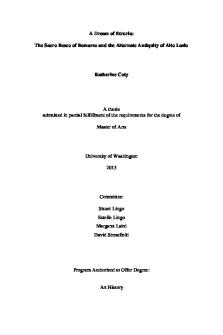PA34Measurement of the Earth, Geographic Memoirs, and Hermes—have all unfortunately disappeared, but were widely quoted in antiquity. The measurement of the size of the Earth by Eratosthenes was descr PDF

| Title | PA34Measurement of the Earth, Geographic Memoirs, and Hermes—have all unfortunately disappeared, but were widely quoted in antiquity. The measurement of the size of the Earth by Eratosthenes was descr |
|---|---|
| Author | Krisha Duan |
| Course | Intermediate Wood B |
| Institution | California State University Long Beach |
| Pages | 3 |
| File Size | 37.9 KB |
| File Type | |
| Total Downloads | 26 |
| Total Views | 119 |
Summary
Measurement of the Earth, Geographic Memoirs, and Hermes—have all unfortunately disappeared, but were widely quoted in antiquity. The measurement of the size of the Earth by Eratosthenes was described by the Stoic philosopher Cleomedes in On the Heavens,¹⁶ sometime after 50 BC. Eratos- thenes starte...
Description
seen by many as an eminently pious enterprise.” For instance, Thierry of Chartres, who taught at Paris and Chartres and became chancellor of the school at Chartres in 1142, explained the origin of the world as described in Genesis in terms of the theory of the four elements he learn ed from the Timaeus. Another development was even more important than the flowering of the cathe- dral schools, though not unrelated to it. This was a new wave of translations of the works of earlier scientists. Translations were at first not so much directly from Greek as from Arabic: either the works of Arab scientists, or works that had earlier been translated from Greek to Arabic or Greek to Syriac to Arabic. The enterprise of translation began early, in the middle of the tenth century, for instance at the monastery of Santa Maria de Ripoli in the Pyrenees, near the border between Christian Europe and Ummayad Spain. For an illustration of how this new knowledge could spread in medieval Europe, and its influence on the cathedral schools, consider the career of Gerbert d’Aurillac. Born in 945 in Aquitaine of ob- scure parents, he learned some Arab mathematics and astronomy in Catalonia; spent time in Rome; went to Reims, where he lectured on Arabic numbers and the abacus and reorganized the cathedral school; became abbot and then archbishop of Reims; assisted in the coronation of the founder of a new dynasty of French kings, Hugh Capet;
followed the German emperor Otto III to Italy and Magdeburg; became archbishop of Ravenna; and in 999 was elected pope, as Sylvester II. His student Fulbert of Chartres studied at the cathedral school of Reims and then be- came bishop of Chartres in 1006, presiding over the rebuilding of its magnificent cathedral. The pace of translation accelerated in the twelfth century. At the century’s start, an Englishman, Adelard of Bath, traveled extensively in Arab countries; translated works of al-Khwarizmi; and, in Natural Questions, r eported on Arab learning. Some- how Thierry of Chartres learned of the use of zero in Arab mathematics, and intro- duced it into Europe. Probably the most important twelfth-century translator was Gerard of Cremona. He worked in Toledo, which had been the capital of Christian Spain before the Arab conquests, and though reconquered by Castilians in 1085 re- mained a center of Arab and Jewish culture. His Latin translation from Arabic of Ptolemy’s Almagest made Greek astronomy avai lable to medieval Europe. Gerard also translated Eu clid’s Elements and works by Archimedes, al-Razi, al-Ferghani, Galen, Ibn Sina, and al-Khwarizmi. After Arab Sicily fell to the Normans in 1091, translations were also made directly from Greek to Latin, with no reliance on Arabic intermediaries. The translations that had the greatest immediate impact were of Aristotle. It
was in Toledo that the bulk of Aristotle’s work was translated from Arabic sources; for instance, there Gerard translated On the Heave ns, Physics, and Meteorology. Aristotle’s works were not universally welcomed in the church. Medieval Chris- tianity had been far more influenced by Platonism and Neoplatonism, partly through the example of Saint Augustine. Aristotle’s writings were naturalistic in a...
Similar Free PDFs

Copy of Bent to the Earth
- 1 Pages

The Importance of Measurement
- 6 Pages

Beyond the sky and the earth
- 2 Pages

The measurement of motor performance
- 11 Pages
Popular Institutions
- Tinajero National High School - Annex
- Politeknik Caltex Riau
- Yokohama City University
- SGT University
- University of Al-Qadisiyah
- Divine Word College of Vigan
- Techniek College Rotterdam
- Universidade de Santiago
- Universiti Teknologi MARA Cawangan Johor Kampus Pasir Gudang
- Poltekkes Kemenkes Yogyakarta
- Baguio City National High School
- Colegio san marcos
- preparatoria uno
- Centro de Bachillerato Tecnológico Industrial y de Servicios No. 107
- Dalian Maritime University
- Quang Trung Secondary School
- Colegio Tecnológico en Informática
- Corporación Regional de Educación Superior
- Grupo CEDVA
- Dar Al Uloom University
- Centro de Estudios Preuniversitarios de la Universidad Nacional de Ingeniería
- 上智大学
- Aakash International School, Nuna Majara
- San Felipe Neri Catholic School
- Kang Chiao International School - New Taipei City
- Misamis Occidental National High School
- Institución Educativa Escuela Normal Juan Ladrilleros
- Kolehiyo ng Pantukan
- Batanes State College
- Instituto Continental
- Sekolah Menengah Kejuruan Kesehatan Kaltara (Tarakan)
- Colegio de La Inmaculada Concepcion - Cebu











